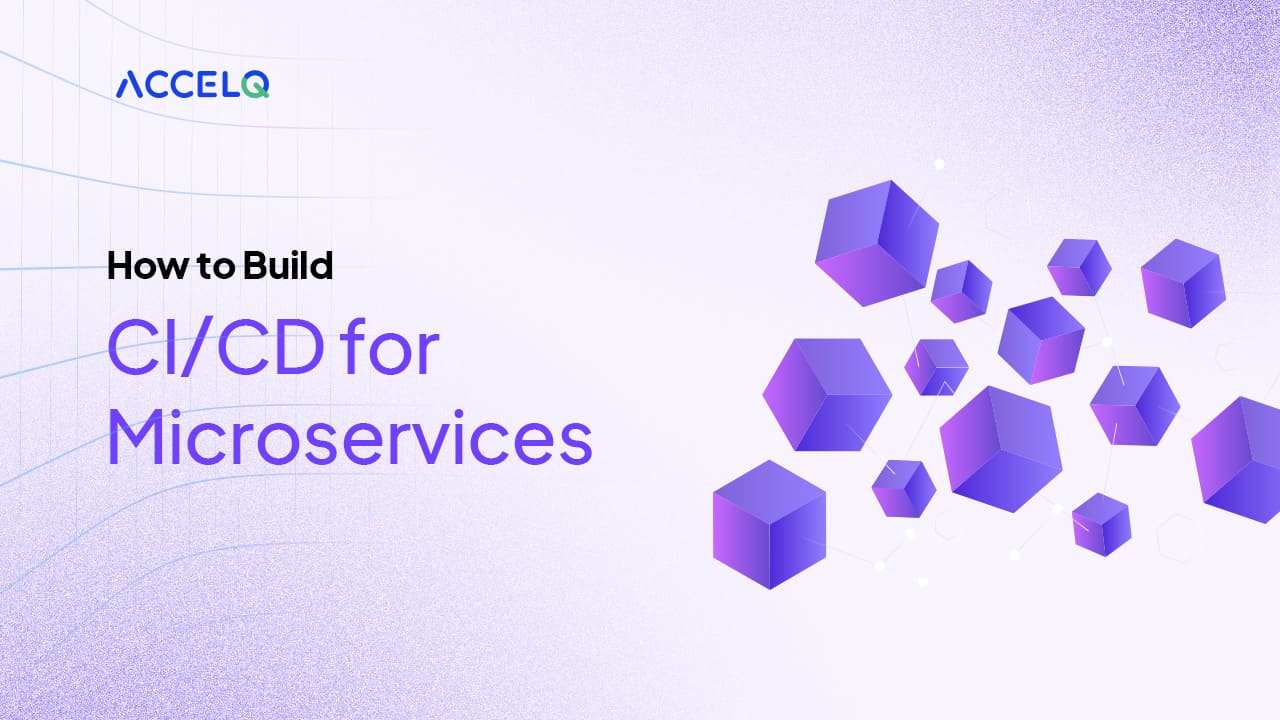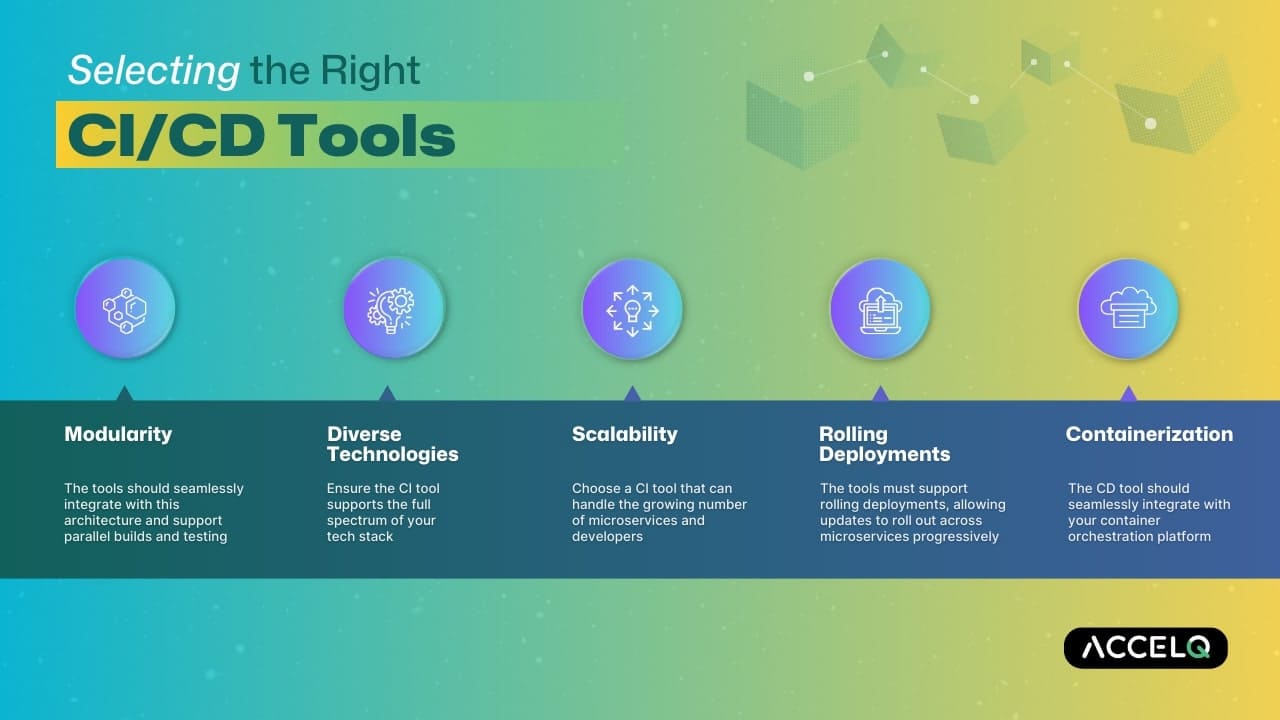How to Build CI/CD for Microservices

Microservices break big and complicated software programs into smaller, independent parts. It helps make software development and deployment more efficient and flexible. The synergy between CI/CD and microservices architecture is paramount for new-age software development. Microservices, by design, promote independence and scalability in application components, allowing for rapid development cycles.
CI/CD for microservices complements this by automating integration, testing, and deployment processes, ensuring the seamless incorporation of code changes into the main codebase, and facilitating microservices swift, independent deployment.
The collaboration of CI/CD and microservices provides consistency across environments, improves visibility and monitoring, and fosters effective collaboration among development teams. They create a robust framework for building, testing, and deploying microservices.
Selecting the Right CI/CD Tools
Selecting the appropriate tool is key to building an efficient CI/CD pipeline for microservices. Consider the following factors to assess the unique demands of your microservices architecture
- Modularity: Microservices are inherently modular. The tools should seamlessly integrate with this architecture and support parallel builds and testing.
- Diverse Technologies: Microservices often use a variety of technologies and programming languages. Ensure the CI tool supports the full spectrum of your tech stack.
- Scalability: Microservices environments are designed to scale horizontally. Choose a CI tool that can handle the growing number of microservices and developers.
- Rolling Deployments: The tools must support rolling deployments. This means allowing updates to roll out across microservices progressively.
- Containerization: The CD tool should seamlessly integrate with your container orchestration platform.
Continuous Integration in Microservices
A CI pipeline comprises automated procedures for constructing, testing and deploying code modifications. It plays an important role in realizing an efficient microservices architecture.
Step 1: Define Pipeline Stages
- Code Compilation – Begin the pipeline with the code compilation stage. This involves transforming source code into executable code. And ensuring that individual microservices are built successfully.
- Unit Testing – Following compilation, integrate unit testing into the pipeline. Write comprehensive tests for each microservice to verify the functionality of individual components.
- Integration Testing – Here, you need to assess the interactions between different microservices. Automated tools and frameworks can aid in simulating real-world interactions.
- Code Analysis – Integrate code analysis tools into your pipeline. This is necessary to check code quality, coding standards, and identify vulnerabilities.
Step 2: Leverage Parallel Execution
Harness the power of parallel execution to optimize testing time and accelerate the CI process. Microservices, being modular, can often undergo testing simultaneously. Configure the CI tool to execute tests in parallel, ensuring that the testing phase is not a bottleneck in your development pipeline.
Step 3: Integration with Version Control System
Integration with your version control system is crucial for a streamlined development workflow. Configure the CI tool to automatically trigger builds and tests upon code changes in the version control system. Encourage the use of feature branches in your version control system.
Configure the CI pipeline to trigger only for specific branches. Also, prevent unnecessary builds for every feature branch. Implement status checks in your version control system to ensure that code is only merged when the CI pipeline is successful. This prevents the introduction of faulty code into the main codebase.
Continuous Deployment in Microservices
A CD pipeline is a series of automated steps designed to ease the efficient deployment of software changes. It automates the delivery process. It ensures that new code changes can be quickly deployed with minimal manual intervention and reduced errors.
Step 1: Design Modular Pipelines
- Containerization and Packaging – Begin the pipeline with the containerization of microservices. Utilize containerization tools to encapsulate each microservice along with its dependencies. Package the containerized microservices for consistent deployment across various environments.
- Configuration Management – Integrate steps for managing configuration files within the deployment pipeline. The files may vary between microservices. Automating their management ensures consistency across different deployment environments.
- Environment-specific Deployments – Craft deployment steps that adapt to different environments. The pipeline must also be able to handle specific configurations and settings.
Step 2: Automated Deployment
Specify the target test environments for deployment. Configure the pipeline to deploy microservices to the appropriate targets based on the pipeline stage. Leverage orchestration tools to manage the deployment of multiple microservices. Orchestration ensures that microservices are deployed and scaled efficiently. Implement version tagging during deployment to track and identify specific releases. This helps in troubleshooting and maintaining a clear history of deployments.
Step 3: Post-Deployment Checks
Execute automated tests after deployment to check the functioning of microservices. This ensures that the production environment aligns with the testing environment. Integrate monitoring tools into the deployment pipeline. Track the performance of microservices post-deployment. Real-time monitoring provides insights into any anomalies or performance issues. Define rollback strategies to identify issues post-deployment. A well-defined plan to revert to a stable version minimizes downtime and potential impact on end-users.
Example of CI/CD for Microservices
Scenario:
A fintech company uses microservices to handle different aspects of its application: one for user management, another for transaction processing, and a third for generating financial reports.
CI/CD Setup:
1. Version Control: All microservices codebases are stored in Git repositories.
2. Continuous Integration (CI):
- Jenkins is configured to watch for changes in any of the Git repositories.
- When a developer pushes new code, Jenkins automatically compiles the code, runs unit tests, and performs static code analysis.
- If everything passes, the changes are considered ready for deployment.
3. Continuous Deployment (CD):
- Docker is used to containerize each microservice.
- Kubernetes manages the deployment of these containers to a staging environment first.
- Automated integration tests run in the staging environment.
- Upon successful testing, the changes are rolled out to production using a blue-green deployment strategy to minimize downtime.
Outcome:
This CI/CD setup enables the fintech company to rapidly develop, test, and deploy changes to its microservices architecture, ensuring high availability and continuous application improvement.
5 Best Practices for Microservices CI/CD
- Implement a diverse range of automated tests. Ensure the integrity of components and catch potential issues early in the development cycle.
- Embrace containerization to encapsulate microservices and their dependencies. This ensures consistency across different environments and simplifies deployment.
- Establish robust versioning and tagging strategies. This helps in the easy tracking of changes and provides a clear roadmap for releases.
- Integrate continuous monitoring tools into your CI/CD pipeline for real-time feedback. Keep an eye on performance, security, and other metrics for quick identification and resolution of issues.
- Have well-defined rollback strategies in place. Despite rigorous testing, unforeseen issues can arise post-deployment. A solid rollback plan ensures quick recovery with minimal impact.
Final Thoughts
Automated testing is indispensable for establishing a robust CI/CD pipeline for microservices due to the unique challenges posed by their architecture. Microservices involve frequent updates and releases, making manual testing impractical and error-prone. Automated tests enable rapid and consistent testing, ensuring that each microservice adheres to defined standards and functionalities.
Embracing CI/CD for microservices empowers your team to catch bugs early, iterate quickly, and deliver value to users. It fosters collaboration, accelerates time-to-market, and helps you leverage cutting-edge development practices. Adopt the CI/CD process with ACCELQ and redefine how you build, deploy, and evolve microservices.
Balbodh Jha
Associate Director Product Engineering
Balbodh is a passionate enthusiast of Test Automation, constantly seeking opportunities to tackle real-world challenges in this field. He possesses an insatiable curiosity for engaging in discussions on testing-related topics and crafting solutions to address them. He has a wealth of experience in establishing Test Centers of Excellence (TCoE) for a diverse range of clients he has collaborated with.
Discover More
 Scalable CI/CD Solutions with Azure DevOps for Enterprise Applications
Scalable CI/CD Solutions with Azure DevOps for Enterprise Applications
Scalable CI/CD Solutions with Azure DevOps for Enterprise Applications
 CI/CD Pipeline with Jenkins: Build, Test & Deploy
CI/CD Pipeline with Jenkins: Build, Test & Deploy

































